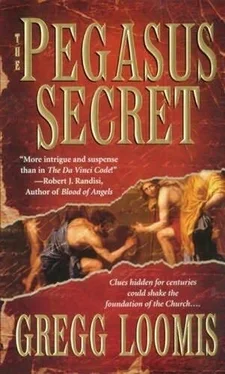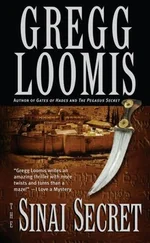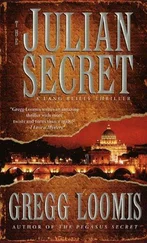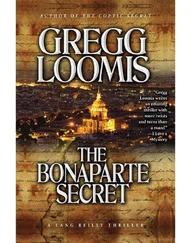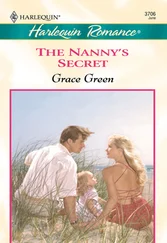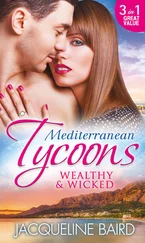"Fra Marcenni?" Gurt called.
The man in the cassock turned. He could have been one of the saints pictured throughout the church. His white hair stood around a pink circle of scalp, catching the powerful light in an electronic halo. He was small, about the size of the pensione's owner and about the same age.
"Si?"
"Do you speak English?" she asked, shading her eyes as she looked up at the top of the scaffolding.
The halo shook: no.
Gurt fired off a burst of Italian.
The monk smiled and replied, pointing behind Lang and Gurt.
"He says he'll come down in a minute or two, that he'll be happy to speak to us. We are to enjoy the art of this magnificent church while we wait."
Lang's lack of interest in religious art applied equally to the magnificent or otherwise. So, instead of feeding coins into boxes to illuminate the paintings in the various chapels, he amused himself by deciphering the Latin epitaphs marking the tombs of prelates and nobility who had contributed generously to this church. The burial places of the poor, no doubt, had long since been forgotten.
The meek might someday inherit the earth but it will be one that doesn't remember them.
Lang studied a small glass vial embedded in the altar, trying to ascertain what holy relic might be enshrined there. A nail from the True Cross, a finger bone of St. Paul?
He never found out.
Gurt took him by the arm. "Fra Marcenni is taking a break. We'll have coffee on the square."
The good brother preferred wine.
They sat alfresco at a table only a few yards from the massive doors of the cathedral. Gurt and the monk exchanged what Lang supposed were the banalities of commencing a conversation with a stranger.
Signaling for a second glass, the old monk said something to Gurt and looked at Lang. "He would like to see the picture we have come to ask about," she translated.
Lang handed it across the table. "Tell him I need to know what it shows."
The monk stared at the Polaroid while Gurt spoke. He replied and Lang waited impatiently for the English.
"Three shepherds are looking at a tomb."
Lang had never considered this possibility for the enigmatic structure. "The woman, who is she?" The old man listened to Gurt and crossed himself as he replied.
"A saint, perhaps the Blessed Virgin herself," Gurt said. "She is watching the shepherds at the tomb, perhaps the tomb of Christ before He arises."
Swell. Lang had come all this way to understand another religious painting. Although the tomb of Christ had always been pictured as a cave, one from which a stone could be rolled. The difference was hardly worth the trip.
He was reminded of the two shipwreck survivors floating in a lifeboat in a fog. Suddenly, they see shore and the figure of a man.
"Where are we?" shouts one of the men in the boat.
"At sea, right off the coast," comes the answer.
"Imagine that," the other man in the boat says. "Running into a lawyer out here."
"Lawyer?" his companion asks. "How the hell do you know he's a lawyer?"
"Because the answer to my question was absolutely accurate and totally worthless."
Like the old priest's answer.
Brother Marcenni must have sensed Lang's disappointment. He took a magnifying glass from somewhere in his cassock and squinted at the picture before speaking again to Gurt.
"He says the letters on the tomb are in Latin, written without spaces in the manner of the ancient Romans."
This was again telling Lang he was at sea. "That much I knew."
As though understanding the English, Brother Marcenni read in a slow, quivering voice, "Et in Arcadia ego sum."
"Makes no sense," Lang said to Gurt. "Both sum and ego are first person. Sum means 'I am' and ego is the first person pronoun."
Gurt looked at him as though he had grown another head.
Lang shrugged apologetically. "Latin is sort of a hobby."
"I never knew that."
"It didn't seem relative to the relationship. We usually communicated in grunts and groans. Ask the good brother if sum and ego aren't redundant."
After treating Lang to a glare that would have singed paint, Gurt and the monk exchanged sentences. He gesticulated as though his hands could solve the mystery.
Finally, Gurt nodded and said, "He says the second denotation of the first person is perhaps for emphasis. The phrase would translate as 'I am also' or 'l am even' in Arcadia but is peculiar usage. Perhaps the artist was speaking alle… alle…"
"Allegorically," Lang supplied.
"Allegorically. As if he were saying, 'I am here also: meaning that death is present even in Arcadia."
"The tomb of Christ is in Canada or Greece? Ask him how that might be."
In reply to Gurt's question, the monk motioned the waiter for yet another glass of wine and laughed, hands moving expansively.
"He says the artist, Poussin, was French. The French are too busy with women and wine to be exact about geography. Besides, Arcadia was frequently symbolic for a place of pastoral peace."
Or anything else, by Lang's observation.
Since he had to drive back down that curving road, Lang was drinking coffee. His cup had gone cold and he motioned to the waiter as Brother Marcenni produced a metrically numbered straightedge and began to measure the Polaroid. He turned the picture sideways and upside down, nodded and spoke to Gurt.
"He says this is not only a picture but a map."
Lang forgot about warming up his coffee. "A map? Of what?"
After another exchange and much waving of hands by the monk, Gurt answered, "Many of these old paintings were maps. The shepherds' staffs are held at an angle that forms two legs of an equilateral triangle, see?" She pointed. "If we draw the third leg, the tomb is in the center. That means the painting, the map, directs the observer to the tomb itself, wherever located."
"He's sure?'
Another question in Italian.
The old man nodded vigorously, laying the straightedge along one axis of the picture, then another.
"He's sure. Shepherds' staffs, soldiers' swords, other objects that are straight were often used as clues. It would not be a coincidence that two legs of the triangle would be at geometrically correct angles."
''A tomb's located between the staffs of two shepherds?" Lang was skeptical.
Gurt shook her head. "No, no. Notice the trees lead from the mountains in the background? If you continue the line of those trees, they reach the tomb, too. Trees also frame that jagged gap in the mountains, see? Brother Marcenni says that if you were in this place and lined the mountains up to match the painting, you would be standing where the tomb was."
The monk interrupted.
"He says it is also significant that the background is not as he remembers it, that the Poussin painting with which he is familiar was different. It would not have been unusual in the artist's day to do several similar works."
None of this had convinced Lang. "He's telling us that this painting was done as a map to Christ's burial place in Greece?" '
Gurt again spoke in Italian. The old man shook his head, crossed himself again and pointed to the picture. the sky
and himself.
"He says of course not. The Holy Sepulchre is in Jerusalem and has been empty since the third day after the crucifixion when Christ rose before ascending into heaven. The tomb in the picture could mean anything, a treasure, perhaps where a vision appeared to someone.
When the painting, or the original from which it was copied, was done, symbolism was fashionable, as were hidden meanings, puzzles and secret maps. If you knew where those mountains were, perhaps in Greece, you. might find whatever the tomb symbolizes."
This was a little better than telling Lang he was at sea.
"So," he said, "that's why my sister and nephew died. Someone wanted to make sure they didn't figure out they had seen a map leading to treasure, or something worth killing for."
Читать дальше
